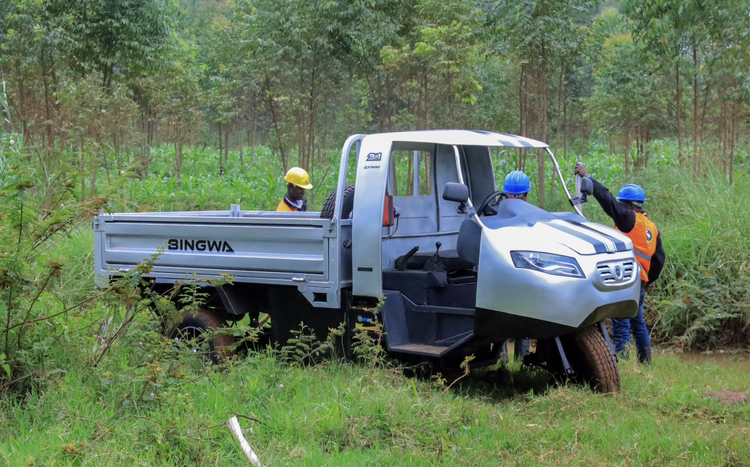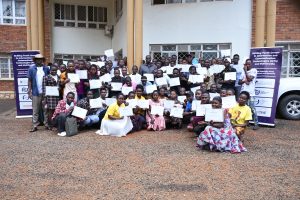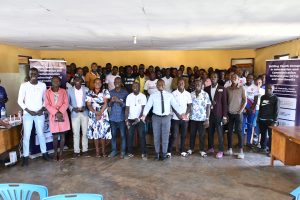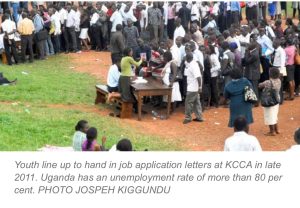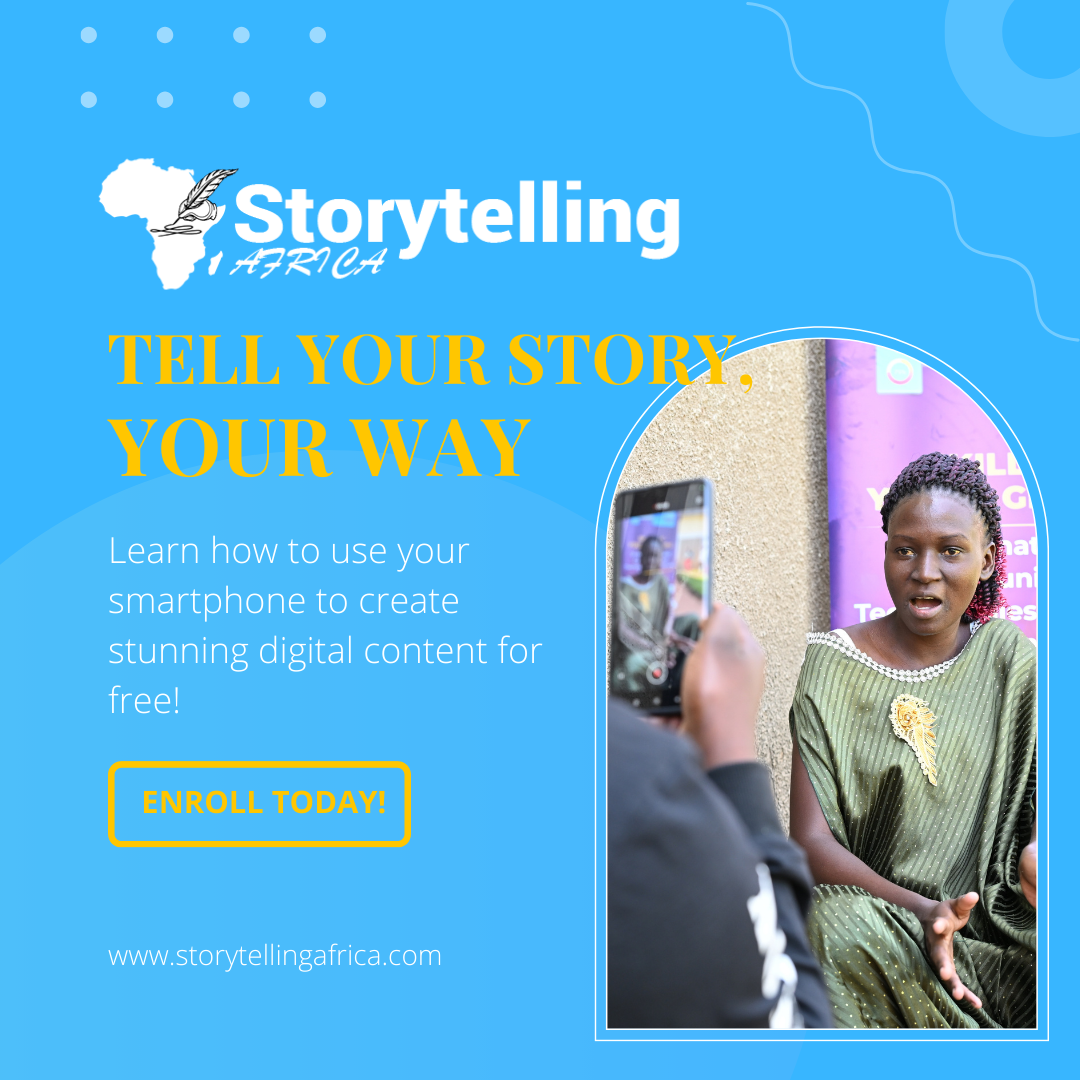Farmers and rural households are set to benefit from a new three-wheeler motor vehicle on the market that enables them to transport their goods, pump water and generate electricity. President Yoweri Museveni is set to launch the trike during celebrations to mark Uganda’s 61st independence on 9 October in Kitgum District.
The trike, named Bingwa, Swahili for champion, is a product of a group of self-trained innovators from the informal sectorled by Rogers Mubiru under their company Kevoton Motions Engineering Ltd.
The engine casting was made at the John Lugendo Foundry in Kibuye in Kampala. Bingwa is powered by a 0.8 litre 2-stroke engine with a potentially higher power-to-weight ratio compared to traditional 4-stroke engines making it fuel efficient and easy to maneuver.
This was revealed by Hon Dr Monica Musenero, the Minister for Science, Technology and Innovation (STI) in the Office of the President during a flag off ceremony held at the Kiira Motors Vehicle Plant in Jinja where the trike was built.
Bingwa, the three-wheeler commonly known as Tuk-Tuk can transport 1,000kg of goods, pump 6,000 litres of water per hour for irrigation and generate 6kW of electricity every hour, thereby solving some of the farmers and rural households’ most immediate challenges.

The STI Secretariat under the Office of the President provided a grant to Kevoton Motions through the National Research and Innovation Program (Innovation Fund) for the domestic manufacture of a 3-in-1 trike for mobility, water pumping and electricity generation. Kiira Motors incubated and supported Kevoton Motions to bring their idea to life.
The Bingwa trike is relatively affordable for smallholder farmers while equipped with technologies that solve their most immediate challenges — transport, water, and electricity.
In Uganda, 90% of the population lives in rural areas while 80% of the households are involved in agriculture according to the Uganda National Population and Housing Census of 2014. However, only 2.9% of the households use irrigation on at least one plot for the first season and 2.4% for the second season. Just 19% of households are estimated to have access to electricity for lighting on the backdrop of an electricity distribution access of 51%.
A solution that addresses the household’s challenges is critical in fostering economic development. “Mobility is a fundamental component for rural development, connecting people to opportunities, services and resources necessary for their well-being and economic progress,” says Hon Dr Musenero.
“Electricity plays a transformative role in rural agrarian communities by boosting agricultural productivity, improving living conditions, enhancing education and healthcare and enabling economic diversification,” Hon Dr Musenero adds.
Dr Musenero committed her support to innovators. “We are behind schedule in terms of innovations and we must therefore work hard to catch up with other continents. My ministry will continue to provide the needed support to innovators to come up with such products,” she said.
She further says that irrigation is crucial in ensuring consistent water supply for crops to improve yields and enhance food security.
All these three functions (mobility, electricity and irrigation) are key components that the Bingwa trike can be able to execute. The Bingwa trike can lead to rural transformation if it is integrated into the Parish Development Model or other government programs.
“We got the idea of developing this engine in 1998 because we didn’t have a product that we could call ours as a country at the time. After attending an exhibition, we started working with Makerere University because of our innovativeness and eventually Kiira Motors under the STI Secretariat that has led to the production of the Bingwa Trike,” says Rogers Mubiru, Founder and Director at Kevoton Motions Engineering Ltd.
“We hope that this development will lead to an offtake of 600 units which can be deployed in different sub-counties across the country to enable households improve their livelihood,” Mubiru says.
The flag off to Kitgum where Bingwa will be officially launched was also attended by Hon Denis Onekalit Amere, the Member of Parliament for Kitgum Municipality who pledged his support to sustainable products. “Bingwa will solve challenges of our people across the country who are predominantly farmers and live in rural areas,” he said. “This is a welcome innovation but we need to ensure that Mubiru and others innovators like him get the support they need so that our country industrializes thereby creating jobs for our people,” he added.
Allan Muhumuza, Mobility Team Leader at the STI Secretariat says that the success of the project has enabled the government to validate an incubation model where a budding innovator, especially in the informal sector is placed under the mentorship of an anchor enterprise like Kiira Motors. “This enables us to transfer skills, utilize existing infrastructure, create institutional capacity and foster synergies towards industrialization,” he explains.
Most of the parts used to make the Bingwa Trike are made locally and many can be made by independent suppliers in the automotive industry value chain thereby making the case for localization and value addition of products.
The support from the STI, which commenced in August 2022 has led to the Bingwa trike being made with 55% local content, according to Albert Akovuku, the Director of Production at Kiira Motors. “The key parts which have been locally made are the engine, the chassis, the frame and the body panels,” Akovuku reveals. “Specifically, 70 out of 128 parts have been made locally. Mass production will be at the Kiira Vehicle Plant in Jinja with initial capacity of 1,000 units per a year growing to 4,000 per a year in the medium term,” he adds.
Realizing the potential of the project, the Uganda Development Bank (UDB) has offered project preparation funding amounting to USD250,000 (approximately Shs900 million) to facilitate the development of the project business plan and production readiness.
The Bingwa trike will cost Shs28 million, lower than what one would spend if they were to buy an ordinary tuk-tuk, water pump, and a power generator. The Bingwa Trike uses diesel.
With an estimated total addressable market of 100,000 trikes in Uganda in the medium term, there is local content opportunity utilizing over 60,000 tons of steel, 10,000 tons of aluminium, 8,000 tons of cast iron and 1,000 tons of plastic components, the Bingwa Trike is a true manifestation of how the automotive industry can solve everyday challenges beyond mobility thereby providing the spark needed for the country’s economic prosperity while fully utilizing its natural resources.
Bingwa Trike Specifications
• Load capacity: 1,000kgs
• Electricity generation capacity: 62kW per hour
• Water pumping capacity: 6,000 litres per hour
• Mass production start date: October 2024
• Manufacturing Plant: Kiira Motors Vehicle Plant Jinja
• Initial production capacity: 1,000 units per a year
• Jobs expected to be created during production: 2,000
• Bingwa Trike Fuel Type: Diesel
• Innovator: Kevoton Motions Engineering Ltd
• Price on market: UGX28m

